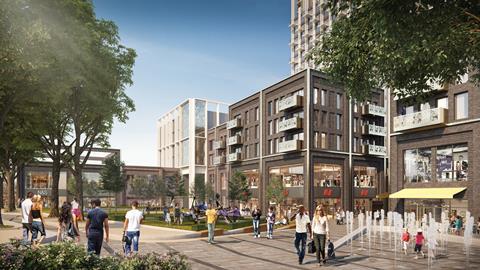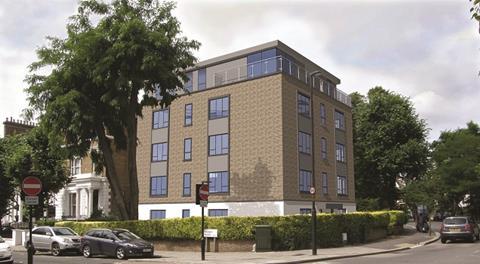Whether it is on top of existing blocks of flats or commercial properties such as shopping centres, warehouses or even car parks, the potential scale of ‘rooftop development’ is enormous.

Knight Frank estimates that 40,000 homes could be built on top of existing buildings in central London alone.
Policymakers have shown their support for rooftop development by including guidance in the draft London Plan last year and, more recently, the proposed new National Planning Policy Framework (NPPF) published earlier this month.
Further good news may be on the horizon if a permitted development right (PDR) outlined alongside the NPPF is given the go-ahead.
But will it be enough to overcome some of the challenges associated with rooftop development such as high build costs and the disruption caused for existing tenants?
Anecdotal evidence suggests interest in rooftop development was already growing before the PDR proposals were announced.
Maximising value
James McAllister, director of the London planning team at GVA, says his team is dealing with a growing number of applications exploring the potential to develop above existing buildings.
“In central London it has been a natural course for developers given the price and scarcity of land and the level of competition they face for conventional sites. We’ve seen interest from the property owner looking at how they can maximise the value of their asset and we’re also getting approaches from speculative developers.”
McAllister says applications are coming from owners of trade centres such as timber and plumbing yards in central London, and outside the city’s core locations he has had approaches from low-rise retail landlords to add residential floors to buildings.
Big developers are also getting in on the act. Capital & Regional’s proposal to build 460 homes on top of Walthamstow Mall is one particularly large example and industrial landlord SEGRO is looking at a number of opportunities in London to build on top of industrial units.

McAllister says growing policy support for upwards extensions in both the NPPF and the London Plan is encouraging, but the proposed PDR goes one step further.
The government’s initial plans are for a PDR that would allow rooftop extensions of up to two floors without the need for planning permission as long as they are in keeping with the roofline of other buildings in the area.
The two-storey limit means the PDR is suited to smaller sites, but McAllister says it still represents a good opportunity for developers.
“I think there is a huge amount of potential supply that would result in employing a development right such as that,” he says.
Apex chief executive Arshad Bhatti has been lobbying for a PDR for some time and last year, the firm conducted research to find out how much new development could be unlocked with a single-storey PDR.
“We thought there were around 3,600 acres of airspace available to build on in London, but the proposed two-storey policy means that could be doubled to more than 7,000 acres,” says Bhatti.
“Everyone has different views about how to use that space, but the key is that it is new space.”
Apex ramps up project pipeline
Apex Airspace Development was one of the first major players in the UK roof-space market when it launched at the end of 2015.
To date, Apex has completed two small projects at Wilmott Place and Abbey Road in the London Borough of Camden, both of which involved building a large penthouse apartment above an existing office building – but its ambitions are much bigger, chief executive Arshad Bhatti told Property Week at Mipim this year.
The firm has another 82 units in the planning process across six schemes, as well as ‘live leads’ on a further 500 to 700 units across 20 schemes. Although the company started off doing single-unit development, it says most of its future schemes will have 20 to 150-plus units.

“It is a case of the more units the better, but there will be structural things that you have to account for,” says Bhatti.
Apex is also speaking to four of the six largest supermarket chains about developing residential units above their properties, and is already working on a 24-unit scheme with Tesco in Harrow, north London.
In a study it conducted of Camden, Apex identified 2,500 potential rooftop units. Based on this, it has estimated that across London there could be space for up to 360,000 units.
Bhatti believes that rooftop development could help to house London’s growing population, which according to the Office for National Statistics is set to reach 9.7 million by mid-2024 – and says London can easily support a higher density of housing.
“There isn’t the land in London to accommodate 10 million people,” he says. “London’s density is only around half that of Paris, and I don’t think many people would say Paris is an ugly city.”
London-based developer Click Above also welcomes the move to make rooftop extensions easier. “The PDR is great news. It is definitely an exciting time for us as a company,” says managing director Aaron Emmett.
He adds that rooftop developments offer many benefits to landlords. “Freeholders can generate additional income from their building, but they can also choose to either sell the air rights to a developer or enter into a joint venture,” he says.
“This allows the leaseholders to share the burden of the service charge and maintenance costs, as well as the freeholder receiving an income from additional ground rent. Improvements to the exterior of the building can also be negotiated while the extra floors are being added.”
Complicated process
Policymakers may take some time to decide on the finer details of the PDR and, if it is implemented, applicants will have to satisfy multiple requirements in order to qualify.
“The PDR may make the process of rooftop developments quicker but it will be by no means a fast track. It will be more complex than the office-to-resi PDR,” says McAllister.
Local authority planners also need to get on board with rooftop development applications if the process is to become smoother and quicker. Anecdotes suggest that so far the reception has been chilly and there are concerns that some councils may choose to veto the use of rooftop PDRs.
The development right would apply to buildings across the country but the high costs of building at altitude mean developments are more likely to be viable in higher-value areas such as London. High build costs are among several challenges faced by rooftop developers.
“The sheer nature of rooftop development is a complicated process,” says Emmett. “Although there are many benefits to the offsite building methods we use to develop roof space, not all buildings are suitable for development.
“The structural integrity of the building needs to be considered along with an access route for cranes to be able to deliver the units and crane them on top of the building. There are a myriad of other legal issues revolving around the existing tenants and their leases that we also have to consider.”
Minimising the impact on the occupier’s business is another factor to take into account. GVA’s McAllister says owner-occupiers are typically concerned about having to vacate their buildings while construction work is carried out.
Advancements in modular construction can help to reduce the amount of time it takes to complete the build, thus minimising the disruption to the occupier.
Tony Dicarlo, managing director of rooftop and modular developer Innerspace, says: “Over the last three years we have phased in offsite construction to all our rooftop developments, which has greatly sped up build times.
“When rooftop development is combined with offsite construction it can reduce build durations by up to 50% compared with traditional build.”
The proposed PDR has sparked optimism among players in the emerging sector and offers another way to boost housebuilding. But to succeed, it needs more than central government backing. Its success is also in the hands of local authorities and until policy details are finalised the strength of their support remains to be seen.






























No comments yet